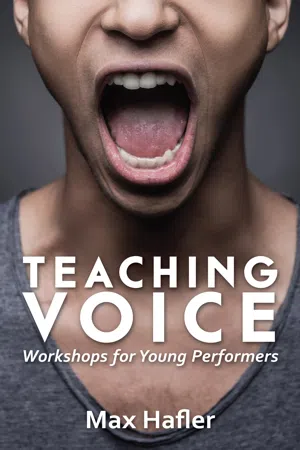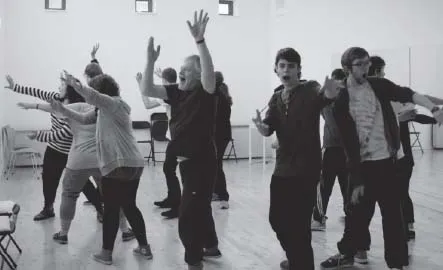![]()
![]()
Core Session 1
Nuts and Bolts
‘The words are rooted with the breath.’
Cicely Berry
In this first core session we introduce the power of the voice, the basic breathing work, theory and practice, floor work, body awareness, feeling of ease/relaxation, listening, diction, vowels, tone and style, and singing. The class is fun, but is primarily technical and energetic. If you do it all, it should last about ninety minutes.
You do not have to follow this plan slavishly. It is what I do, and you will have your own style. In addition, you might want to shift components around depending on the nature of your group, to say nothing of the venue, how much time you have, the participants’ backgrounds and whether you are working in a youth theatre, school or college. I will give guidance, but these adjustments are up to you. I think if it if suits your group, you could stand to use this same plan for a few sessions with just a different poem to work on at the end.
If ninety minutes is too long then split the session into two. If you are more inclined to start with short sessions you might go straight to the micro sessions in Part 3, and come back to these longer sessions. However, these first two sessions are the bedrock of the work, so if you can, start here.
You need to take your time if you are new to the work. You might feel that you yourself only feel confident enough to take a small piece of these sessions. That is okay too. Do not get too overfaced by all the explanations. Initially every exercise needs explaining to you with care and that takes space in the book. It does not take as long to do them!
The Room, the Warm-up Sheet and You
Ideally you must try and have a room which is light, airy, and big enough for people to move around in. Importantly, it needs to have a decent floor which is not too cold and which is clean and comfortable to lie on. If it isn’t easy to lie on the floor you can try some of the breathing work in the Qigong standing position we explored in your own warm-up (but that is really a later stage of the work, so if you can manage to get the students lying on the floor, then do so). If you are in a gym there might be mats available. If not, perhaps they can be encouraged to bring in their own mat. As they are going to lie on the floor and do a lot of movement, people need to be in clothes that are, as they say, ‘comfortable to move in’.
I have always supplied the participants at the end of the first session with a copy of a warm-up sheet they can do at home right from the start. If you do this, stress regularity; five minutes’ practice a day is better than thirty minutes a week. Some of my home warm-up (printed at the back of the book and available to download on the Nick Hern Books website) involves them making sound, but they can do it silently if they are afraid how others may react. The important thing to stress initially is that they try and reintroduce the body to breathing diaphragmatically through the exercises. For the teacher/facilitator, this should be the most important goal initially with their work at home.
Maybe you will have done some of the exercises in the Introduction that day to prepare yourself, before you start with the group. It is important to remember that voice work more than any other theatre tool needs the body and mind as easy as possible, especially when you are starting out.
Part One: Starting the Session
Letting It Go
A good exercise for leaving the day behind.
• Begin by getting the group into a circle, and ask them simply to breathe and stand, feel their feet on the floor, and get a sense of where their body is uneasy or even tense. Have them bring their attention to that place, and say inside, just ‘let go’. Ask them to close their eyes and get a sense of being in the room, to get a sense of where they are in the room, where the walls are, what it feels like to be in this circle with this group, their friends, to get ready to start on their drama session. To listen for sounds. To feel the atmosphere.
• Suggest they imagine that all around each of them is their day and their concerns of the day. Get them to imagine what these concerns look like. Are they buzzing around? Are they floaty? What? Is a thought grabbing onto them like some little creature? What does it feel like in their imagination?
• Everyone is going to step forward with their eyes closed and step out of that little atmosphere of their thoughts and concerns. Suggest they step forward and then leave the thoughts behind.
• Ask them to open their eyes. Look around at their friends and share their energy with them. It is okay to laugh or smile but not to talk. Ask them to notice if they feel differently.
• Ask them to turn back to their little atmosphere. With a big sweeping gesture and a shout, all together they sweep their thoughts and concerns away.
So now it is time to introduce the work. It is important you explain the importance of the voice, how much of the work is important not only for acting but for life itself, and how when you go on the stage you have pretty much yourself to work with. You are your instrument.
Ask: what are the things you need to speak clearly, and loudly for the stage? Explore the responses, but know that our first stop is going to be breathing…
Happy Birthday (1)
• Ask the group to breathe in deeply and sing ‘Happy Birthday’, and keep going without taking a breath. This might be hard for some. Tell them not to cheat by taking sneak breaths.
• Ask for feedback. What happens to the voice as the breath runs out? Answers might be… ‘It gets quieter’, ‘It makes me tense’, ‘It sounds weak’, ‘It doesn’t go anywhere’. So we need a lot of breath to power the voice. It is our fuel, and powers everything we do. Be aware that this might be the very first time this has occurred to them.
Some Theory
With the right groups the theory can be useful, upfront. With others it can be off-putting. You decide.
• Ask them to consider the moment before they go to sleep, how they let go and their breathing changes. You might find it useful here to explain the theory behind diaphragmatic breathing, which we went through in the Introduction. It can be useful to demonstrate the action of the diaphragm by using your arms, knitting your fingers together in a ‘cradle’ loosely together in front of your body. As you breathe in, the ‘cradle’ goes down, then as you breathe out, the ‘cradle’ rises.
• Tell the group that it was the way they breathed when they were born, that it is taught in relaxation classes all over the world and is fundamental to many disciplines, such as yoga, Qigong, etc. Explain that it is quite natural to feel challenged about changing your breathing behaviour. It is useful to reassure those who have been to singing class that they will notice a slight difference in the technique. Neither is wrong.
Please note: It is important to tell them that there will be a lot of physical work, and only they know whether they have any physical issues they need to take care of. They need to look after themselves, and come and explain afterwards if there is anything they have to avoid. You need to be very reassuring about this, because doing this work can create a lot of anxiety for some young people.
Part Two: Warm-up
I suggest you do all these exercises with the group. If you do them, they are less likely to be so nervous about doing them. The exercises I use are based on theatre training, yoga and t’ai chi. They are all leading up to the floor work.
General Tips
Firstly, a tip on pace. Once you start the stretches part of the warm-up, you can up the pace considerably if you feel it is necessary, to keep them interested. Ideally it is better to start slow, as it makes them more aware of their movement, and they are less likely to hurt themselves, but varying the pace can be helpful to retain their engagement.
Also, i...

